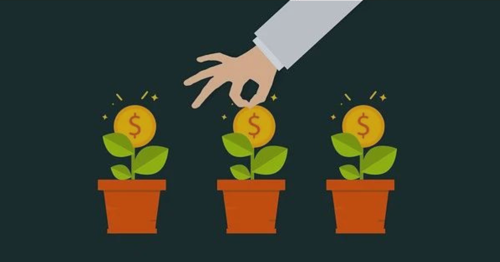What is Funding? Understand The Different Types of Funding
Funding Funding Round Company Funding

An Introduction to Company Funding
When founders establish a new company they have a variety of different expenses to meet. It is no secret that purchasing the necessary equipment to get you up and running is essential. It is also very likely that you need money for renting business premises, to meet monthly utility costs, and pay for general expenses.
More importantly, money is needed to recruit the right talent for your business. Without these key employees, it is unlikely you will get your business off the ground in a progressive and structured way.
But those costs do not stop there. To continue to grow and compete in your chosen market sector you also need funds.
So, where does the money for all of the above come from? - The straight answer is from investors. However, there are different types of investors who see funding in different ways. This means it is important for founders to understand exactly what these types of investors are and what they expect in return for their investment.
Let’s break this down starting with….

What is Company Funding?
The funding a company receives comes from the amounts offered by investors. This usually comes in two forms of financing; equity (also known as stock) and debt (in the form of loans or bonds). This investment is given to provide the company with operating capital.
We will shortly get into the various types of funding and explain briefly what the 2 types of initial funding are and how they differ from other types of investment received. But before that here’s further detail as to what standard company funding is.
When a company receives funding either through the mentioned equity or as debt, these investors can be termed shareholders or bondholders. They give such investment with the expectancy of receiving returns on their investment. These returns can come through different methods. Examples are stock appreciation, dividends, or interest on the amount given.
There are a variety of factors for founders to consider before deciding on which type of company funding best meets their needs. Such things as growth forecasts and projected increases in revenue need to be taken into account.
Here’s how initial funding is generally found followed by an explanation on 2 major routes to funding and then a look at some alternative funding methods.

Initial Company Funding and Where it can Come From
Initial company funding is the money required to get your business up and running. This can come in various forms from personal, informal, and more formal fundraising.
The first is known as “Bootstrapping” and all necessary funds come from the founder’s savings or received credit.
From there, friends, family, and any associates who believe in your idea are often the next port of call. At this stage of funding, these ‘investors’ are usually in it through their personal belief in the founder’s ideas or cause rather than for purely financial reasons.
The next stage is the more formal process of fundraising and is often termed “seed capital” or “seed funding”. The term “seed” comes from the fact that this initial investment is where your company starts. From there this investment is given with the expectation that it will help your business to grow into a healthy, blossoming company.
While seed funding can come from family and friends it can also be secured through crowdfunding or angel investors. When it comes to seed funding, investors will expect a return on their investment.

Two Major Routes to Funding
Let’s take a look at two major routes to find the funding that will be used to ensure continued and consistent company growth. This funding can come from either raising sufficient capital through debt and/or raising that capital through the issuing of stock.
A company can do this through the issuance of common stock by issuing extra shares in their company to investors. Those companies that are more established may need this extra capital to ready themselves for an IPO (Initial Public Offering).
Either way, the cash received from investors can be utilized to fund the required capital initiatives. Of course, these investors will expect a return on the amount(s) they have invested. This is termed ROI (Return On Investment) and is also known as the cost of equity to the business.
When this capital is used effectively it can increase the company’s share value to meet investors’ expected or agreed ROI or the company can opt to pay dividends.
While these are ways to secure funding there are also drawbacks for founders. This is because issuing extra shares in their company reduces all current shareholders’ stock holding and means dilution of company ownership as well as reduced voting rights.
An alternative way to raise funds is by issuing investors corporate bonds. Once these bonds are issued, the borrowed amount from investors comes in the form of semi-annual coupon payments until the bond is fully paid off.
It is the coupon rate applied upon issuing the bond by the issuing business that outlines the cost of this debt. In addition to this, bond investors have the option to buy a bond at a discount and the actual value of the bond would then be compensated once it matures.
An example here would be when an investor buys a bond for $3,000, they would receive a payment of $4,000 when the bond matures. The difference in these amounts is how debt investors make their money. As for the company, they pay the bond amount plus interest off once they begin to grow.
Other Company Options to Raise Funding
While the above methods are popular options for raising funds they are not the only ways. A company can take a traditional route by arranging a loan from a bank or commercial lending operation. Once this type of loan is established it is seen as a long-term liability that is reduced as the loan is repaid over the agreed period.
As will be clearly understood, this type of loan needs to be paid back with high-interest rates. However, that is deemed as a company expense and it means the tax paid on company profits would be reduced accordingly.
Using this type of institutional or a bondholder loan does mean that your company is not liable to give any payment to the shareholders. This is because you are paying all interest and coupon repayments to the bondholders or lenders. For this reason, companies that raise funds through debt will find this a much more expensive option than if they opt for the equity funding route.
Having said this, if the company happens to go bankrupt and its assets are liquidated, it is the creditors who would be paid first and before any shareholders are paid.
Because of the many different ways for a company to raise the necessary funding, it means long thought is required before deciding which method is best for your particular business. One route that many startups focus on is getting funding from VCs (Venture Capitalists). While VCs tend to focus on specific business sectors, if your company fits into their investment profile this can be a highly effective way to raise the additional capital required.

What is the Importance of Fundraising to Your Company?
A startup venture is exactly that, a business that is spawned through a founder’s ideas and beliefs that the products or services they want to bring to the market will be successful.
The challenge here is that getting a new company up and running and then starting a sustained growth curve costs money. While the initial funding from founders, friends, and family helps to evolve the business plan it is not enough to sustain it.
Without the much-needed initial and ongoing additional investment, most startups would fail before they even have a chance to begin establishing themselves.
It should be said that there are cases where companies do not require funding. Examples are founders that can self-fund (bootstrap themselves) or a company that is assured of rapid high growth right from the start but these cases are exceptions rather than the rule.
Company funding is not only required to get things up and running and to pay for initial monthly outgoings, it is also needed to hire key employees, bolster sales and marketing initiatives, and get your name out there.
This makes fundraising a key component of a company’s progression and should be viewed as an essential part of your business journey.
Raising funds can be looked at as a double-edged sword. On the one hand, there are lots of investors out there waiting to invest in the right startup. On the other hand, there is huge competition for investment.
While it is likely you will suffer rejections from some quarters you must persevere. It also goes without saying that the stronger your business plan, the ability to give projections and show how you expect your company to grow will leave you in a far stronger position when it comes to securing the investment you are after.
That leads to the question….

When is the Right Time to Raise Funding for Your Company?
This is something that all founders need to think very carefully about. We have touched on the need to have a realistic business plan in place. This needs backing up with a belief in your product(s) or services. Such a ‘pitch’ must be persuasively presented to potential investors with any available data/statistics to back it up.
Putting over the right ‘story’ is a must if you are to tempt investors to give you funding. If you already have even a little customer traction this must be highlighted. Equally, if you feel technology will help your cause then demonstrate this to the full.
The right time to raise funding must be seen as a balance. Too early in your new venture’s life will mean you have not settled on an exact direction or have any product to show. You also need to understand the target market you will go for and compare the ‘uniqueness’ of your product or services to others in that sector.
Leaving it too long to raise funding could sink your ambitions. Do not try to over-complicate things or wait until everything is ‘perfect’. Investors understand that there will be modifications and improvements along the way. What they are looking for is a simple explanation of your product or services – Prototype examples certainly help.
This balance and time to seek funds can be met when founders feel they have a product or service that fits the market sector they are in and they can highlight growth potential.

How Much Funding Should be Raised?
In the perfect world, a founder would be able to raise the necessary amount of funds to cover all of their startup costs, keep them afloat until break-even level, and still have sufficient funds to begin a profitable growth cycle.
Achieving this would mean that should you need further funding to grow your business or expand your line of products or services that next round of funding would be much easier. This is because you have already proven your worth through the original business concept and have a base company structure in place to support that.
However, we don’t all live in that perfect world and this means that some startups will need to follow up on initial seed funding. Make no mistake, this is certainly achievable.
With the right focus as well as proof that you are moving in the right direction then reaching out to investors after 12 to 18 months of operation is the way to go. Keep a close record of your successes and do not be afraid to highlight mistakes you have learned from.
This will put you in a stronger position to present your case for funding with projected forecasts on where you expect to be at a given date if the required funding is received.
Beware of Giving too Much Away!
Before jumping in with both feet and requesting too much funding for too large a chunk of your company take a step back. Founders must consider the variables involved and what the trade-offs are. It may be very tempting to seize an offer that looks lucrative in terms of a larger amount of funding than expected, but what would you be giving up for that?
Diluting too much of your company ownership must be avoided. Look at things this way, during the initial seed round of funding if you can give up just 10% of your company for the funds required you are onto a winner. But being realistic you should expect a 20% dilution. It is not advised to accept such funding if dilution reaches 25% or more.
One very sensible route to achieving the funding you need is to create various plans showing different amounts you want to raise. This should be a minimum amount to keep your company on the right track, a nice-to-have preferred amount, and an amount that is higher than initially needed but would be used for faster product or service expansion.
Doing so, it will help you gauge at what pace you can move forward. While this may be slower, as preferred, or faster, it will still stand you in good stead to progress healthily.
A clear outline for each step of your business journey presented to investors will show them how their money would grow. That is what they are looking for!
To help you forecast how much funding you will need consider two things:
- What period you will need this funding for (generally between 12 and 18 months).
- Work out your projected overheads for that period. This should include all costs such as business premises rental, and costs of key personnel (not just those you currently have but any you feel will be needed during the above period – add their salaries pro-rata). Then include such things as development costs.
These costs will vary dependent upon the products or services you are offering but you should have a good handle on what they will be.
Founders can then take the total amount of funding required and divide it by different periods (i.e. 12, 15, and 18 months). This will give you flexibility in the amount(s) of funding needed.
Many startups would look for between $500,000 and $1.5 million but of course, this varies tremendously and will depend upon the business sector you are in and your specific needs.
This means you could go for less than the $500,000, or way over the $1.5 million mentioned. Carrying out due diligence as near as possible will leave you in a much stronger position to achieve the realistic amount of funds required.

Real World Funding Scenarios and an Example
Everyone has heard of the huge success of companies such as Amazon, Google, Apple, and Facebook. They all started with the founder’s belief, energy, and determination (plus of course a great idea that offered products and services to the masses!)
But, here is a much more recent success story that shows exactly why persistence is something that all founders need.
Instagram – THE #1 Photo-Sharing Application
As all will be aware, Instagram is a free photo- and video-sharing application that enables users to take photos/videos, apply relevant filters, and share them via social networks.
Instagram’s incredible rise to fame and fortune in just a few months will stagger many, but do not believe for one minute that it was all plain sailing!
The social media application took just 8 weeks for software engineers to develop before being launched in October 2010 on Apple’s mobile operating system. In under 2 years, Facebook (META) acquired the company for $1 billion in cash and stock!
Let’s backtrack with some basic founding and funding detail
Kevin Systrom, a 27-year-old graduate of Stanford University was working at a travel recommendations startup; Nextstop. His previous work experience included time with Google and as an intern at Odeo (the company that would later evolve into Twitter).
Systrom had no formal computer science training but was determined to learn code at night and during weekends while working for Nextstop. The result was a prototype of a web app; Burbn – (inspired by his taste for fine whiskeys and bourbons).
This app allowed users to check in, post their planned activities and share photos. While location-based check-in apps were common at the time, it was the photo-sharing feature of Burbn that made it stand out.
A crucial turning point….
It was at a startup party (for Silicon Valley-based Hunch) in March 2010 that things turned dramatically. Systrom met and gave a demonstration of Burbn to 2 venture capitalists from Baseline Ventures and Andreessen Horowitz.
The result? After another meeting, Systrom quit his job, focussed on developing Burbn, and within 2 weeks had raised a total of $500,000 in seed funding (from both the mentioned venture capitalist companies).
We have already mentioned the importance of seed funding in terms of recruiting key employees. That is exactly what happened with the recruitment of 25-year-old Mike Krieger (also a Stanford graduate) who knew Systrom from their time as students. Krieger’s previous experience was as an engineer and user-experience designer for the social media platform Meebo.
Between the two of them, the Burbn app was reassessed and the decision was made to primarily focus on one aspect; photographs that were specifically taken using mobile devices.
Leading apps in the photography category were studied and it was the Hipstamatic app that stood tall. While very good, Hipstamatic lacked the social media sharing capability. This led Systrom and Krieger to build an app that bridged Hipstamatic and a social media platform (aka Facebook).
Burbn was stripped down to its photo, commenting, and ability to “like” posts. This improved app was renamed Instagram (a combination of Instant and Telegram). A key factor was that the app should be minimalist and require users to take as few actions as possible.
The new Instagram app took the mentioned 8 weeks of fine-tuning and beta-testing between friends. It was on Oct 6, 2010, that the initial Instagram iOS app was officially launched.
Successful? It racked up 25,000 users in one day! By the end of its first week, users had downloaded Instagram 100,000 times. Roll on to mid-December of that year and the user base had reached 1 million.
Series A funding and then acquired by Facebook
With such a sudden rise in the user base, more investors became interested. In February 2011, Instagram entered a Series A funding round and raised $7 million.
One of these investors was Benchmark Capital which put Instagram’s value at around $25 million. It is little surprise that other leading social media technology companies (including Twitter and Facebook) were attracted.
While this new round of financing gave the opportunity to hire lots more people, Systrom and Krieger resisted that and kept the company small, employing around 12 employees only.
It is reported that Twitter made a formal offer of around $500 million in stock but this offer was declined. Roll-on to 2012 and just prior to Instagram’s IPO (Initial Public Offering), Facebook acquired the company for $1 billion in cash and stock on 9th April of that year.
Just four of many key facts worthy of note before and after the Facebook acquisition:
- By March 2012 the Instagram user base had grown to around 27 million users.
- When Instagram released the app for Android phone users in April 2012 it was downloaded over 1 million times in less than 1 day.
- By 2018 Instagram became the second-most downloaded free app available from the Apple app store (it was second only to YouTube’s free mobile-device app).
- By 2020 more than 1 billion people were using Instagram each month.
As is very clear in the case of Instagram and other high-profile startup successes, securing the necessary funding at various stages of your company’s life is an absolute must.
In the conclusion below there is a solution that will give you assistance, advice, and the potential to leverage the necessary funding in a way that will benefit your venture.
Conclusion
Whether you are a founder of an early-stage venture or one that is beginning to establish itself one thing is clear, understanding funding and the different options available for fundraising is essential.
To help you along this complex road, expert advice should be sought. That is exactly what the highly-experienced team at WOWS Global can bring to the table.
We offer private market solutions that are second to none. Our digital ecosystem has been designed to unify companies and investors.
Not only can WOWS Global advise and guide you through the funding maze, but our state-of-the-art, online, highly secure systems will provide you with all the tools necessary to run your company most efficiently. That includes access to our sought-after cap table management suite.
For further details and a no-obligation discussion please reach out to us at:contact@wowsglobal.com
Related Posts
-

Early-Stage Investors Funding Funding Round Fundraising for Founders Investor
Shh! Don’t Share These Fundraising Insider Secrets
Startup founders need to fasten their seatbelts and prepare for a roller-coaster ride if they are to achieve success. It is a straight fact that founders will find themselves wearing many hats to get their venture up, running, and thriving. -

Fundraising for Founders Funding Funding for Founders Fundraising Rounds
The Things We got Wrong About Fundraising
Founding a successful company is no easy feat. It is no secret that startup founders will find countless challenges that need to be overcome along the way. However, the belief, determination, and effort you put in to be at the helm of a growing, well-structured and healthy company are worth all of that effort and some. As a founder, you would not be human if you did not make mistakes along the way. That is part of the journey and learning from such mistakes will make you even stronger. With mistakes in mind, the fundraising process that founders go through is a major area where mistakes are made. Here are some key pointers that founders get wrong during the fundraising process. Understanding these and avoiding them will make your fundraising efforts much more effective. -

Finance Funding Raising Funds Simple Agreement for Future Equity
KISS or Keep It Simple Security Convertible Note
Raising funds to ensure your startup thrives is a challenge that most founders face. Offering equity for the funding you intend to raise is one very tried and trusted way to achieve this but it is not the only method. Those founders who need to raise capital to grow their company can take advantage of convertible security instruments. In this respect there is one that really stands out; a KISS convertible note, alternatively known as a Keep It Simple Security. Here’s what KISS is all about and how it can be used to leverage those much-needed funds for your venture: -

Cap Table Finance Funding Startup
Startup Cap Table Management in 2022 – What to Know as You Grow
Startups need investment in order to raise capital and grow their business. This funding comes from investors who are known as shareholders and it is no secret that any potential investor will want returns. -

Cap Table Finance Funding Startup
Easy Cap Table Management for Early-Stage Companies
Getting your startup off on the right footing means there are a whole host of things that need putting in place. While the early stages of such a venture are the beginning of an exciting chapter it can also be an extremely hectic one. -

Funding Fundraising for Founders Investment Investor
Master These 8 Powerful Habits for Success in Fundraising
Startup founders will quickly realize that fundraising is an art. The more effective your fundraising efforts are, the more likely you are to raise those much-needed funds in the required timescales.
